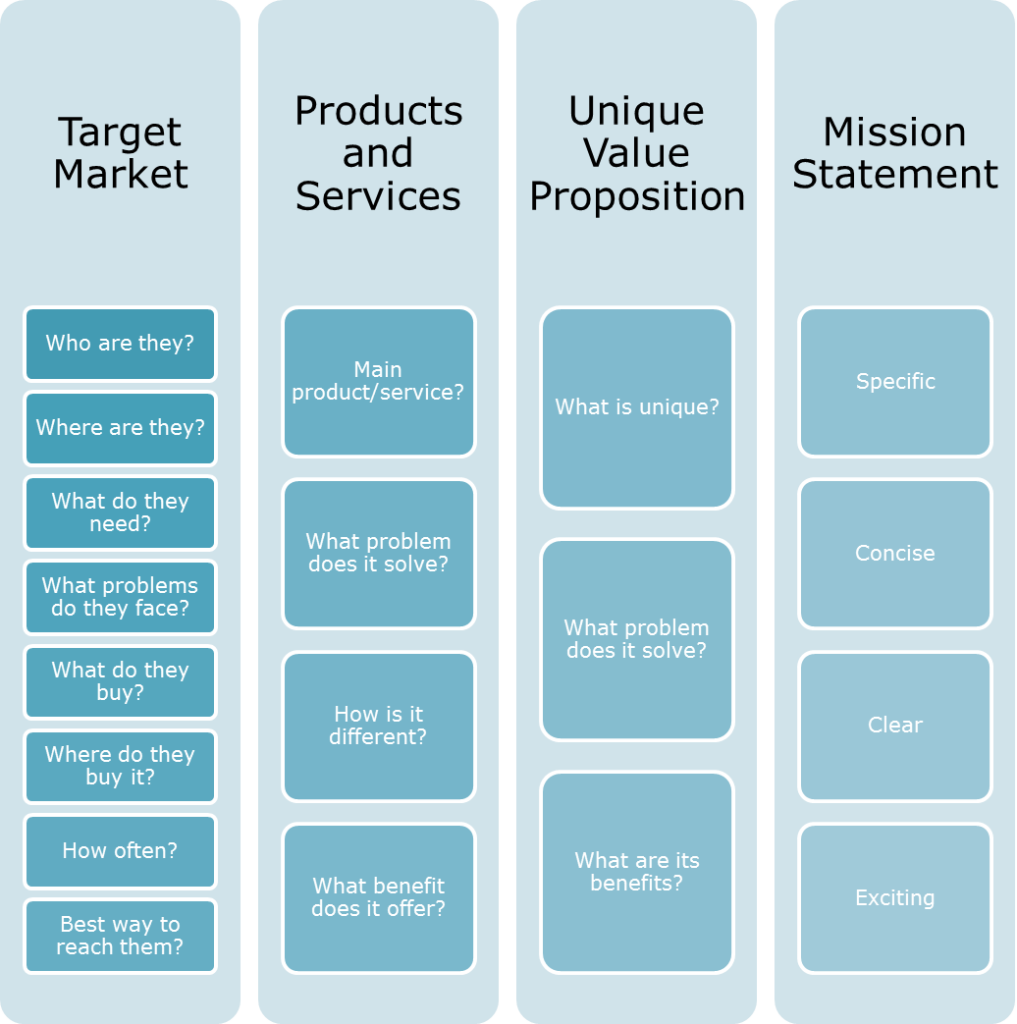Module 4: Describe Your Company
What Do You Need to Include in Your Description?

Start by Defining Your Target market
It’s not someone you hope you’ll be able to sell to, but a person who is a good match for what you’re offering. If you can clearly identify this person, you know exactly who you need to get your message to, and this maximizes the effectiveness of your marketing efforts.
To define your target market, create a profile for an individual who would be the perfect match for your products or services.
This profile should include basic demographic information such as age, gender, location, socioeconomic status, lifestyle, family structure, etc. It should also include psychographic information that includes your target market’s worries, fears, problems, values, likes and dislikes, shopping habits, worldview, etc.
Here are some simple questions you can ask to get started identifying your target market:
- Who are they?
- Where are they?
- What do they need?
- What problems do they face?
- What do they buy?
- Where do they buy it?
- How often do they buy it?
- How do they make their buying decisions?
- What is the best way to reach them with your marketing message?
In creating this profile, be as specific as possible. Your company shouldn’t and can’t be all things to all people. You’re looking for the perfect match. If you have more than one ideal customer, make a profile to define each unique segment of your market.
For example, your offerings may be of value to people in two very different demographics. If this is the case, split your target market.
How to Present Your Core Services
Identify the specific features and benefits that make it valuable and helpful for your target market. Explain how your services are different from similar offerings in the market.
Think of your core services as a brand. Rather than looking at the nuts and bolts of the product, focus on the benefits it offers your customers and how they perceive it. Describe the image of the services in the minds of your customers.
Set Yourself Apart with a Unique Value Proposition
Your UVP shouldn’t say that you’re the best at something, but that you’re the only company in the market who does it in this particular way. The UVP explains why your offering is the only one that makes sense for your customers.
Writing a unique value proposition is no easy task. It takes quite a bit of refining until you get it right. Start by brainstorming and answer these questions:
- What is unique about your offering?
- What specific problem does your offering solve and how?
- What are the key benefits of your offering that no one else gives?
Your company doesn’t have to be the first one to ever offer a particular service. Instead, your service may be unique because it combines two ideas or presents an old idea in a new way. It may be unique because it’s the only product of its type aimed at a particular segment of the market. Brainstorm to reveal the uniqueness of what you offer.
Defining Your Mission and Vision
They explain your business’s purpose. This is the framework from which your marketing strategies are formulated.
People often mix up the two terms – mission and vision. However, what you need to know is that a short ‘vision statement’ is usually one sentence, or even just a few words, that tell the high level view of who you are.
Your mission statement can be a tiny bit longer, preferably just a few sentences at most. It can give a little more information about your company’s purpose. You’ll have plenty of opportunities to explain in more detail what your business does in other parts of your marketing plan.
Your mission/vision statement should explain who you provide value to, how you provide this value, and, like your UVP, what makes you unique. It’s less specific and comprehensive than your UVP and more about the image of your company.
There are four key elements to a good mission or vision statement:
- It’s specific. Avoid language that is vague or that doesn’t tell the customer anything. If it could apply to any company in the world, or even any company in your industry, it’s not good enough.
- It’s concise. There should be no fluff. Every word in your mission statement should mean something. Your statement doesn’t have to be short necessarily, but every word should count.
- It’s clear. No matter how clever or artistic your idea may be, it needs to be clear and easy to understand for the customer. It’s better to be obvious than obscure.
- It’s exciting. This is difficult to pinpoint exactly, but a good mission statement gets the reader excited. Try telling a story, inspiring emotions, and sparking interest with your statement. Ask others to read it in order to get their objective opinion.
Here are a few examples of good mission and vision statements:
Google – “To organize the world’s information and make it universally acceptable and useful.”
McDonalds – “To provide the fast food customer with food prepared in the same high-quality manner worldwide that is tasty, reasonably-priced & delivered.”
Amazon – “Our vision is to be Earth’s most customer centric company; to build a place where people can come to find and discover anything they might want to buy online.”
Nike – “To bring inspiration and innovation to every athlete in the world.”
Starbucks – “Our mission: to inspire and nurture the human spirit one person, one cup, and one neighborhood at a time.”
Aflac – “To combine aggressive strategic marketing with quality products and services at competitive prices to provide the best insurance value for consumers.”
Denny’s – “Our Mission at Denny’s is to establish beneficial business relationships with diverse suppliers who share our commitment to customer service, quality and competitive pricing.”
Action Steps
Brainstorm and complete each section carefully… but remember you can return later on if you come across anything you’d like to add.
Todd McCall
I help practices who are marketing professional services get the attention they deserve by developing an online presence that converts visitors into clients.

